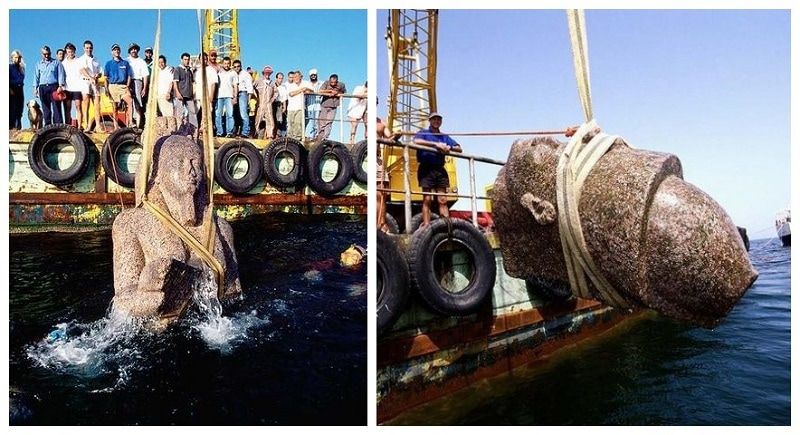The Lost City Of Heracleion Discovered Deep Underwater After 1,200 Years
For centuries, the ‘ lost city of Atlantis has eluded explorers and is almost certainly the stuff of myth. Staggeringly, though, an ancient city that is Atlantis in all but name has emerged from under the sea near Alexandria — and now the lost world of Heracleion is giving up its treasures.
Like in the classical tale, Heracleion was once a wealthy, prosperous place, around 1500 years before it was swallowed up by the sea. It was grand enough to be mentioned by the Greek writer Herodotus, the 5th-century BC historian.
He told the fabulous story of Helen of Troy, the most beautiful woman in the world — she of the face that launched a thousand ships — travelling to Heracleion, then a port of ‘great wealth’, with her glamorous Trojan lover, Paris.



But no physical evidence of such a grand settlement appeared until 2001 when a group led by French marine archaeologist Franck Goddio stumbled upon some relics that led them to one of the greatest finds of the 21st century.
Goddio was in search of Napoleon’s warships from the 1798 Battle of the Nile, when he was defeated by Nelson in these very waters, but came upon this much more significant discovery. Goddio’s team has since been joined by the Oxford Centre for Maritime Archaeology and the Department of Antiquities of Egypt to produce a wealth of dazzling finds.
The archaeologists first faced the mammoth task of reassembling massive stone fragments on the seabed before they could haul them to the surface. Twelve years on, their fabulous finds have been exposed to public view for the first time after more than a millennium spent beneath the silt and water of Aboukir Bay, 20 miles north-east of Alexandria.
Among the discoveries are colossal statues of the Egyptian goddess Isis, the god Hapi, and an unidentified Egyptian pharaoh — all preserved in immaculate condition by their muddy burial shroud. Along with these 16ft statues, there are hundreds of smaller statues of Egyptian gods — among them the figures that guarded the temple where Cleopatra was inaugurated as Queen of the Nile.
It seems the Amun-Gereb temple at Heracleion was the Egyptian equivalent of Westminster Abbey, where our own Queen was crowned 60 years ago. Dozens of sarcophagi have been found, containing the bodies of mummified animals sacrificed to Amun-Gereb, the supreme god of the Egyptians. Many amulets, or religious charms, have been unearthed, too, showing gods such as Isis, Osiris and Horus.
These were made not just for the Egyptians but for visiting traders, who incorporated them into their own religions and also, one imagines, kept them as trinkets to remind them of their far-flung journeys. The importance of Heracleion has been further proved by the discovery of 64 ships — the largest number of ancient vessels ever found in one place — and a mind-boggling 700 anchors.
Other finds illustrate how crucial Heracleion was to the economy of the ancient world. Gold coins and lead, bronze and stone weights from Athens (used to measure the value of goods and to calculate the tax owed) show that Heracleion was a lucrative Mediterranean trading post.
In the ancient world, the Mediterranean Sea was their equivalent of a superfast motorway. All their greatest cities, including Constantinople, Rome and Athens, were either on the coast or on rivers with easy access to it.
And now Heracleion can be added to their number as Egypt’s most important port during the time of the later pharaohs. It was, if you like, a major motorway junction — the spot where the Nile, Egypt’s lifeline, met the Med. Archaeologists have determined that as well as having a naturally navigable channel next to its ancient harbour, a further artificial channel appears to have been dug to expedite trade.
The Heracleion finds will add tremendous depth to our understanding of the ancient world — not least because, among the discoveries, there are perfectly preserved steles (inscribed pillars) decorated with hieroglyphics. Translated, they will reveal much about the religious and political life in this corner of ancient Egypt.
It was a similar inscription on the Rosetta Stone — discovered in the Nile Delta town of Rosetta in 1799 by a French soldier, and now in the British Museum — that cracked the code of hieroglyphics in the first place.
And like the Rosetta Stone, those steles found beneath the waters of Aboukir Bay are inscribed in Greek and Egyptian, too. Who knows how many more archaeological gems will be uncovered at Heracleion?
The very name of the city is taken from that most famous of Greek heroes, Heracles — aka Hercules — whose 12 labours, from killing the Hydra to capturing Cerberus, the multi-headed hellhound that guarded the gates of the Underworld, captivated the ancient world.
Heraklion, Crete’s capital and largest city, is also named after Heracles, as was Herculaneum, the ancient Roman town that was buried under ash when Vesuvius erupted in 79 AD.
It appears that Heracleion faded in importance in the later classical period, eclipsed by its neighbouring city of Alexandria, which became the capital of Egypt in 312BC.
Still, Heracleion lingered on, later under Roman control, until it slipped into its watery grave some time in the 6th or 7th century AD. What a thrilling discovery we have on our hands now that the sea has, 1,500 years later, giving up one of its greatest secrets.
